
OAS Executive Committee
President- Dave Dunn, Ph. (801) 544-7705
Vice Pres- Lee Priest, Ph. (801) 479-5803
Secretary- Bob Tillotson, Ph. (801) 773-8106
Treasurer- Doug Say, (801) 731-7324
Vol. 30 Number 3 December 2000 http://physics.weber.edu/oas/oas.html
December's Meeting
The regular monthly meeting of the Ogden Astronomical Society will convene in the Ott Planetarium on the Weber State University campus at 7:30 p.m. this Thursday December 14, 2000. The president has arranged a "Show and Tell" program so members can, again, describe and display their recent astro-toys and projects. If you have something new, bring it.
Dave is also anticipating the arrival of a new astronomy video program which may be shown if it arrives in time and if meeting time allows.
2001 Desk Calendars Are Here
Alan Jensen took orders last month for the Astronomy desk calendars. The shipment has arrived and Alan will have the calendars at Thursday's meeting to pick up. The price is $9.00 each. If you have questions you may contact Alan at (801) 776-3098.
MINUTES
OGDEN ASTRONOMICAL SOCIETY
November 9, 2000
The regular monthly meeting of the Ogden Astronomical Society was called to order at 7:35 p.m. in the Ott Planetarium on the campus of Weber State University. President David Dunn conducted.
The Bates Elementary school star party that was mentioned at last month's meeting has been postponed until Spring. Information will be forthcoming.
A private star party for OAS members only has been planned for November 25th. Members can meet at Mark Durrwacher's home in West Point, Utah before dusk.
John Sohl announced that the WSU observatory has received a donation of a 16 inch Meade telescope which will be available for members to use at public star parties. OASer's who check out the telescope will be expected to help train local school staff and students on the use of the telescope. For additional information contact Dr. Sohl.
The evening's topic video was shown. "Apollo 16 - Nothing So Hidden" was a summarization if the flight of Apollo 16 to the moon.
Following the movie, Bob Tillotson distributed the Astronomy wall calendars to those who had ordered them.
Dave Dunn displayed a new set of 15X70 mm binoculars that he had purchased for only $99.00. Dave took orders from some members for another order.
The meeting adjourned at 8:45 p.m.
Bob Tillotson, Secretary
OAS and SLAS Combine Efforts for Harmon's Public Star Party
While the parking lot lights at the Harmon's grocery store in Roy didn 't make for the best sky
viewing, the November 4th, nine day old moon, Jupiter and Saturn brought lots of oohs and ahhs
from several hundred people that came to see the night sky or who were just passing by on their
way to the store. There is always a considerable number of people who have never looked
through a telescope and this is a great way to introduce astronomy to those folks who wouldn't
normally have any contact with viewing the night sky.
't make for the best sky
viewing, the November 4th, nine day old moon, Jupiter and Saturn brought lots of oohs and ahhs
from several hundred people that came to see the night sky or who were just passing by on their
way to the store. There is always a considerable number of people who have never looked
through a telescope and this is a great way to introduce astronomy to those folks who wouldn't
normally have any contact with viewing the night sky.
Included in the crowd were several groups of school kids who were there as part of their class assignments.
Harmon's sponsored this star party and several others in the Salt Lake area as a tool for promoting astronomy to the public. Also at this event, the OAS invited the Salt Lake Astronomical Society (SLAS) to participate in order to promote their new observatory project at Stansbury, near Tooele, Utah.
 The night sky was clear and everyone seemed to enjoy the event. Harmon's provided hot
chocolate and cookies with the proceeds going to SLAS's observatory project. Among the SLAS
members who attended were Bruce Grim, Siegfried Jackmann and his 9 inch Clark refractor and
Patrick Wiggins with his 6 inch refractor.
The night sky was clear and everyone seemed to enjoy the event. Harmon's provided hot
chocolate and cookies with the proceeds going to SLAS's observatory project. Among the SLAS
members who attended were Bruce Grim, Siegfried Jackmann and his 9 inch Clark refractor and
Patrick Wiggins with his 6 inch refractor.
The OAS group brought along B.O.B. and telescopes owned and operated by Dave Dunn, Bob
Tillotson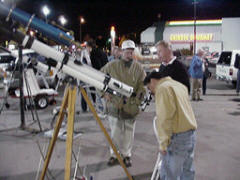 , Mark Durrwacher, Alan Jensen, Karen and Deloy Pierce, Jason and Jeremy Mathews,
Doug and Jeff Seager and Lee and Carol Priest. Doug Say and Diane stopped by to help set up
the Sky Wizard on B.O.B. but there wasn't much deep sky viewing to be had under the
conditions.
, Mark Durrwacher, Alan Jensen, Karen and Deloy Pierce, Jason and Jeremy Mathews,
Doug and Jeff Seager and Lee and Carol Priest. Doug Say and Diane stopped by to help set up
the Sky Wizard on B.O.B. but there wasn't much deep sky viewing to be had under the
conditions.
The event proved to be a terrific opportunity to show off our telescopes and get together with our neighbors from the south.
Lee Priest, Vice President
Photographs by Dave Dunn
Cliff Peterson's,
'The Art of CCD Imaging'
Astro-imaging is sometimes difficult this time of year because of weather and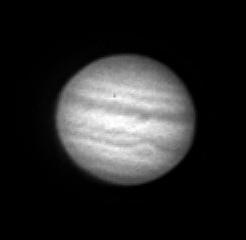 inversions.
November 2nd was a clear day so I took it off to try and get some images. After setting up the
camera that evening and getting a fairly good focus, I had to wait until 2:30 a.m. on Friday the 3rd
before Jupiter and Saturn were overhead so I could gets the best image.
inversions.
November 2nd was a clear day so I took it off to try and get some images. After setting up the
camera that evening and getting a fairly good focus, I had to wait until 2:30 a.m. on Friday the 3rd
before Jupiter and Saturn were overhead so I could gets the best image.
When I went out the stars were twinkling badly so the seeing was not the best. It was cold so rather than go through a refocus cycle I just shot several images. To my surprise I got the Great Red Spot and didn't even know it was in view. The image above, is a 200 percent blow up of that image. It is a bit over processed but still shows some detail. One of the interesting things about Jupiter is that if you shoot an image of the same part of the planet a month later - it will show differences.
In my estimation, a CCD is a great tool because it will allow imaging even when the light
pollution is so bad as to throw a shadow and still get some fairly good images. If you have dark
skies, which I don't, it can be even better
Cliff Peterson.
Jim Seargeant's - Images
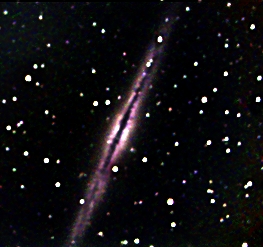
Spiral Galaxy NGC 891, type Sb, in Andromeda
This image of NGC 891 is another taken by four of Adam Johnston's Weber State students, Chris Hansen, Debbie DePierro, Ami Wilcox, and Geoff Wilson on 6 Oct. (That session ran long into the night.) Like last month's image of M27, this one is a luminance-red-green-blue (LRGB) combination of five separate shots (two luminance). The exposure times were L, 360 sec; R, 360 sec; G, 540 sec and B, 1080 sec. As always, the final image would be greatly improved by taking many more exposures to combine into the final. I'd also like to turn the camera sideways to capture the full extent of the galaxy. The 12" Meade LX200 was operating at f/6.3, the SBIG CCD camera at medium resolution, and the AO7 was guiding using .15 second exposures.
This is the last color image that I have available. I bought the color filter wheel used (along with
another ST7 camera), found that I really enjoyed the color but wanted the newer wheel with
built-in infra-red filters. I sold the filter wheel and will get a new one after I raise a bit of money
by selling the spare ST7 (see ad). I'll also upgrade the imaging chip on my original ST7 to the "E"
version, which gives greatly improved blue sensitivity.
The following is from Students for the Exploration and Development of Space (SEDS) at
http://www.seds.org/messier/xtra/ngc/n0891.html.
"NGC 891 is a fine edge-on spiral with a faint dust lane along its equator. According to
Admiral Smyth, it is another discovery of Caroline Herschel, who found it in August, 1783.
Her brother William Herschel cataloged it as H V.19.
Gilbert A. Esquerdo and John C. Barentine have investigated NGC 891 in the infrared part of the electromagnetic spectrum, and suspect that this galaxy might have a bar (and thus be of Hubble type SBb) which is not seen in the visible image because of its edge-on orientation.
NGC 891 is a member of a small group of galaxies, sometimes called the NGC 1023 group, which also contains NGCs 925, 949, 959, 1003, 1023, and 1058 as well as UGCs 1807, 1865 (DDO 19), 2014 (DDO 22), 2023 (DDO 25), 2034 (DDO 24), and 2259.
Supernova 1986J was discovered in NGC 891 by van Gorkom, Rupen, Knapp, Gunn on August 21, 1986 and reached mag 14."
Jim Seargeant
Crossword Challenge
by Jeremy Mathews
- Object Names -
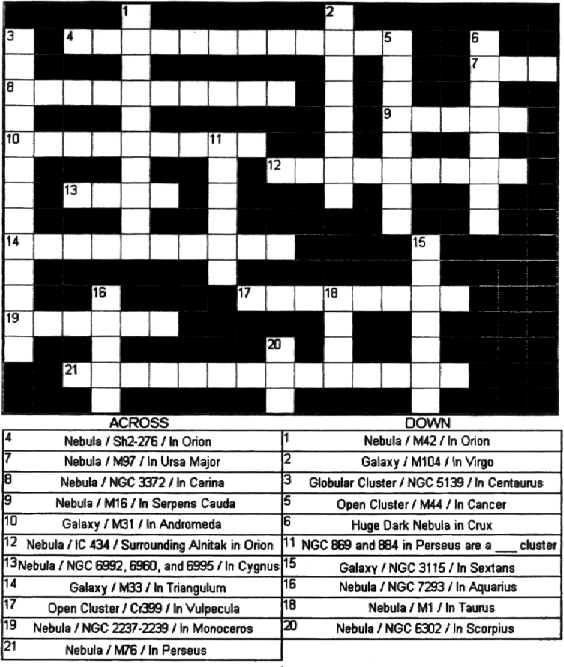
Answers to Last Month's
Crossword Challenge - Star Names
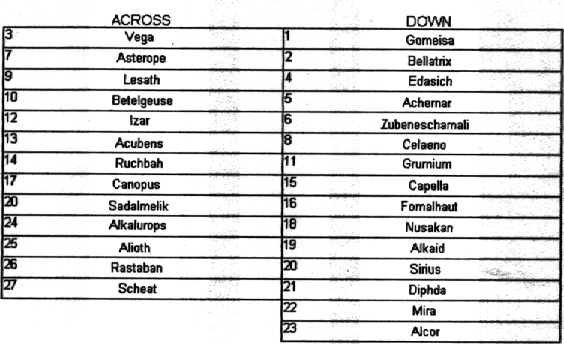
This could be your space.
The Star Diagonal is still searching for an OAS member to contribute a monthly column for
the newsletter. This is someone's opportunity to join the club's editorial staff and exercise
your talent for writing and expand your knowledge in astronomy.
Contact Bob Tillotson: bob@skyplanner.com